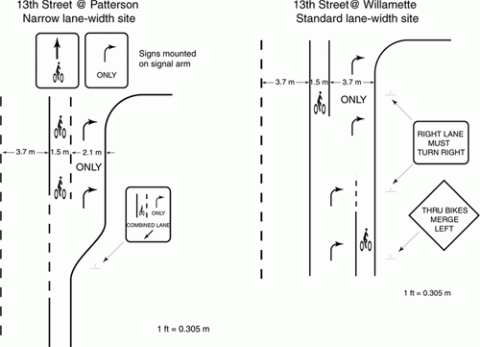Milwaukee230 West Wells Street - Suite 706 Tel - 414.207.4426 |
Madison403 Venture Court - Suite 2 Tel - 608.320.6710 |
Eye Contact Does Not Mean a Driver "Sees" You
 Would you believe that experienced drivers are more likely to "look but not see" a bicyclist than a new driver? Is it possible for a driver to actually look at a bicyclist in the roadway and not "see" the bicyclist? Do drivers focus on situations that are more harmful to themselves and ignore situations that may injury or kill a bicylist? Yes.
Would you believe that experienced drivers are more likely to "look but not see" a bicyclist than a new driver? Is it possible for a driver to actually look at a bicyclist in the roadway and not "see" the bicyclist? Do drivers focus on situations that are more harmful to themselves and ignore situations that may injury or kill a bicylist? Yes.
A few common reasons for bicycle vs. motor vehicle collisions include: 1. Obstructions 2. Diversion of attention by drivers 3. unpredictable behavior by bicyclists. One theory of why drivers don't see bicyclists involves pattern recognition. According to this theory, people don't actually see with their eyes, they see with their brains. The brain can only focus on so much without overload and thus priortizes what it sees. Certain things like billboards, birds, deer, etc. are ignored while things like police cars, semi trucks etc. are given priority and thus more easily "seen."
In Psychological Factors Affecting the Safety of Vulnerable Road Users: A Review of the Literature, by Ian Walker University of Bath, the author concluded that people have a highly limited ability to receive visual information and can fixate on fewer than three points per second at the very maximum (Citing Moray, 1990). To compensate, people's mental models of what is happening guide attention to the most important surrounding perceptions. The author also found that in some situations drivers just do not look at a certain area because they do not expect any personal danger (example-drivers don't look right before making a right turn). Citing (Herslund and Jorgensen, 2003) the author found that in "looked but failed to see" collisions a driver may be looking in the right direction and still not even see a bicyclist because they are not consciously aware that the bicyclist is there at that time. This phenomenon happens more with experienced drivers because they likely have more narrow attention focus on the perceived danger areas. Id. In a study titled Bicycle Accidents and Drivers' Visusal Search at Left and Right Turns, the researches found that drivers turning right scanned the right leg of the T-intersection less frequently and later than those turning left. The study found that drivers develop a visual scanning strategy which concentrates on detection of more frequent and major dangers but ignores and may even mask visual information on less frequent dangers. Another study used actual video recordings taken from 90 collisions captured by onboard cameras. See: Driver Beahvior in Car To Pedestrian Incidents: An Application of the Driving Reliability and Error Analysis Method . Two main causation patterns were found. 1. In intersections drivers failed to recognize the presence of the conflict pedestrain due to visual obstructions and or because they were paying attention to something other than the conflict pedestrian. 2. In non-intersection situations, the same pattern occured along with a pattern showing unexpected behavior by pedestrians. A similar study, Requirements of a System to Reduce Car To Vulnerable Road User Crashes in Urban Intersections, found similar causation-most frequent contributing factor to the collisions was the drivers' failure to observe the bicyclists and other vulnerable users due to reduced visibilty, awarness and or not comprehending.
In Attention and Expectation Problems in Bicycle-Car Collisions: An In-Depth Study, the researchers found that in 37% of the sampled collisions, neither driver nor cyclist realized the danger or had time to yield. Interestingly, while only 11% of the drivers noticed the bicyclists before the collisions, 68% of cyclists noticed the driver before the accident, and 92% of those who noticed believed the driver would give way as required by law.
The above summary of studies is helpful in understanding safe bicycling practice. To lesson the chance of collisions with cars, bicyclists should do certain things. These include riding in a predictable manner when safely able. Of course, riding in a predictable manner will not help when a driver "looks but fails to see." In that case, the bicyclist must assume the driver does not see he or she. People often say things like assume the cars don't see you. Oftentimes, bicyclists think this just means to generally ride safely. The bicyclists don't make the connection that a driver may actually look directly at you and still not "see" you.
Another important consideration to keep in mind is the frequency of collisions at intersections. When approaching an intersection, be aware that your chance for collision with a motor vehicle just went up by about 75% compared with a non-intersection. When riding, keep in mind that the human brain tends to priortize risks when observing things behind the wheel. Things that can cause great harm to a motor vehicle driver (like a semi) are more easily "seen." When riding in rural areas be aware that the human brain may not be expecting to see a bicycle and thus you are at a higher risk. Do not assume laws like the three foot law will protect you. Laws often do little or nothing to encourage safe driving behavior and often are only applicable after a collision happens. Many police officers are not even aware of specific Wisconsin bicycle laws. If the police do not know the laws, do not expect a driver to know them. Do not assume drivers will follow any of the laws. For a very informative article about the eyes, vision, and additional reasons why drivers do not see bikers, click here.
